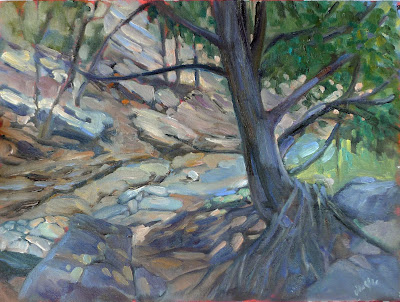All painters should occasionally go somewhere else to paint, even if it’s just the next town over.
 |
| Snow squall at Twelve Corners, by Carol L. Douglas |
It’s 3° F at my house. That’s positively balmy compared to other places in the north. It’s -13° in the Dakotas, -11° in Detroit, and so cold in Saranac Lake, NY that the National Weather Service refuses to speculate. This is what newscasters are breathlessly calling a polar vortex. It’s just our old friend winter, rebranded.
I was born and raised in Buffalo, NY. I have antifreeze in my veins. The coldest weather I’ve ever painted in was -10°F. That was about twenty years ago, when I made the commitment that I’d paint outdoors six days a week for a whole year through. Sub-zero weather is a fact of life in Western New York, as are blizzards and wind-swept deluges in the warmer months. I painted through it all.
 |
| Path, by Carol L. Douglas |
I came away from that year realizing two things. The first was that if you paint that much, you have to sell your work, if only to be able to afford more paint and canvases. That was the start of my consistent business practice.
More importantly, I didn’t need to do it again. Now I paint outdoors in the winter because I want to, not because I’ve got something to prove. That means I can set limits: no subzero weather, no gloomy days, and no howling winds. Snow paintings are best with sunlight.
One more thing I’ve only recently concluded: you can’t skimp on winter clothes. I’ve spent way too much time being cold because I was underdressed. That’s foolish.
 |
| Hayfield, Niagara County, NY, by Carol L. Douglas. The lumpiness in the paint is because it was so cold even my oils froze. |
The painting above was done in a hayfield in Niagara County, NY. When I packed up to leave, I realized my van had a dead battery from the cold. Twenty years ago, I didn’t have a cell phone, so I trudged down the road to call my brother. “I was wondering what on earth you were doing there,” said the kind lady who answered the door. My brother just called me an idiot.
What do plein airartists do in the winter? Mostly, we paint indoors. All of us have ideas for studio paintings, commissions, etc., that need to be executed sometime. If we have any sense, we also rest. I haven’t done a good job of that this year; I’m scrambling to finish work before the season starts again.
 |
| Rock wall, by Carol L. Douglas. Winter means a lot of twilight in the north. |
If we’re lucky, we sneak in a short trip South to paint, as
I did last winter. This year, I’m being contrarian and flying west instead, to New Mexico (where it’s a balmy 25° and sunny today).
Jane Chapin and I plan to paint some winter mountain scenes high above Santa Fe. Yes, we have mountains in the Northeast, but they’re a very different character.
All painters should occasionally go somewhere else to paint. It doesn’t have to be an expensive, extensive trip. If you live on the coastal plains, go to the hills. If you live in a town, go to the countryside. Even the smallest shift of viewpoint profits us. The land has a different shape, different focal points, different light, different masses. We stretch when we paint what’s outside our norm.
 |
| Suburban snowstorm, by Carol L. Douglas. Wherever there are trees and snow together, you can paint a landscape. |
I leave Monday, weather permitting. I’m starting to pack my winter gear. But first, I must clear the driveway and bring in more wood. Ah, winter! You may be beautiful, but you’re also a lot of work.




















